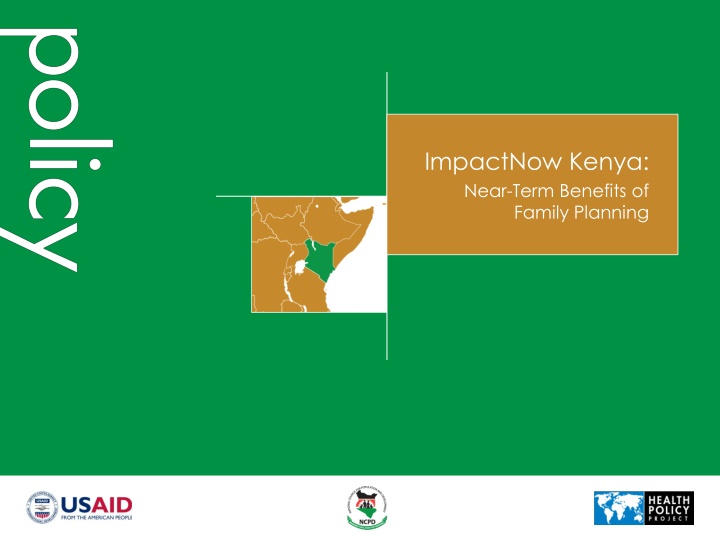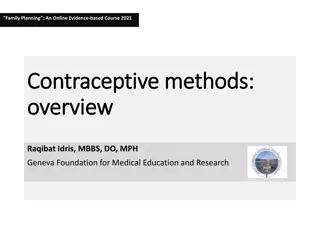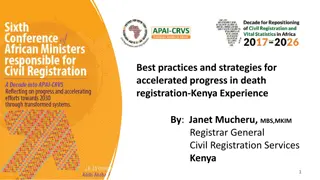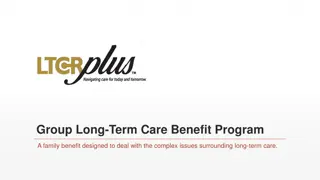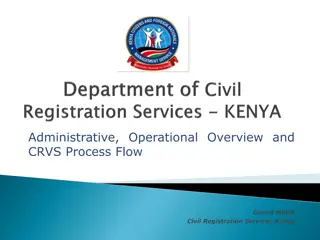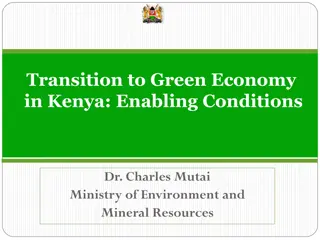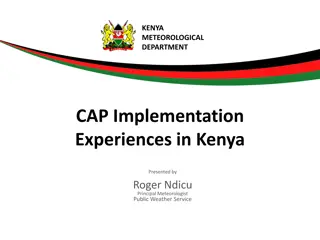Near-Term Benefits of Family Planning in Kenya
The ImpactNow Kenya initiative focuses on the importance of family planning in Kenya, highlighting current challenges, popular contraceptive methods, and the potential impact on healthcare and economic development. Through the Population Policy for National Development, Kenya aims to increase modern contraceptive prevalence rates, emphasizing the need for government prioritization and support.
Download Presentation

Please find below an Image/Link to download the presentation.
The content on the website is provided AS IS for your information and personal use only. It may not be sold, licensed, or shared on other websites without obtaining consent from the author.If you encounter any issues during the download, it is possible that the publisher has removed the file from their server.
You are allowed to download the files provided on this website for personal or commercial use, subject to the condition that they are used lawfully. All files are the property of their respective owners.
The content on the website is provided AS IS for your information and personal use only. It may not be sold, licensed, or shared on other websites without obtaining consent from the author.
E N D
Presentation Transcript
ImpactNow Kenya: Near-Term Benefits of Family Planning
Currently in Kenya The number of children the average woman will have in her lifetime 3.9 Married women (18%) who do not want to have a child but are not using family planning 1 in 5 Teenagers (23%) who do not want to have a child but are not using family planning 1 in 4
Meanwhile The injectable an expensive contraceptive is the most popular method Providers often lack training in the provision of more effective and less expensive methods of FP, such as implants and intrauterine contraceptive devices (IUCDs)
The Context In 2012, Kenya launched the Population Policy for National Development (PPND) PPND aspires to increase national use of modern contraceptives to 58% by 2020 and 64% by 2025 Since PPND, Kenya has increased its modern contraceptive prevalence rate (mCPR) to 53% among currently married women Kenya is currently on track to surpass its 2020 target (58% mCPR)
The Solution To ensure further progress, national and county governments must prioritise modern FP in their policies, programmes, and budgets Prioritising modern FP will save the lives of mothers and children and promote economic development
What would it mean for Kenya if county governments accelerated access to and use of voluntary modern FP?
ImpactNow Kenya Model and Results The goal is to attain high quality of life for the people of Kenya by managing population growth that can be sustained with the available resources. Population Policy for National Development, 2012
The Model The ImpactNow model quantifies the health and economic benefits of family planning INPUTS HEALTH OUTPUTS ECONOMIC OUTPUTS Unintended pregnancies averted Health status FP costs Contraceptive effectiveness Live births averted Direct healthcare costs averted Unsafe abortions averted Patterns of contraceptive use Cost-benefit ratio Maternal deaths averted Pregnancy- and birth-related healthcare utilisation and costs Cost-effectiveness Infant deaths averted
The Scenarios Scenario-based, the model is designed to show the impacts of three FP policy options and compare results Assumes little or no change in the policy goal in the future Low Effort PPND Assumes incremental improvement/change PPND+ Assumes the most ambitious goal
Model Scenarios for Kenya Scenario Key Characteristics Modest improvements in mCPR, below the recent percentage point improvement (2.3 annually) Low Effort mCPR reaches 58% by 2020 as envisioned in the PPND PPND Aligned with PPND 2025 mCPR goal (64%) Recent momentum in mCPR continues, with uptake growing at 2.3 percentage points annually PPND+ Improvements in access to long-acting, reversible, and permanent contraception
Modern FP and Method Mix by Scenario Low Effort 2020 56.2% Baseline 2015 PPND 2020 PPND+ 2020 53.2% mCPR 58.0% 64.7% Method Mix Condom 4.1% 4.1% 4.1% 4.1% Injectable 49.6% 49.6% 49.6% 30.0% Pill 15.0% 15.0% 15.0% 7.5% Female Sterilisation 6.0% 6.0% 6.0% 9.0% Male Sterilisation 0.0% 0.0% 0.0% 2.0% IUCD 6.4% 6.4% 6.4% 16.4% Implant Other Modern (lactational amenorrhea method) 18.6% 18.6% 18.6% 31.0% 0.30% 0.30% 0.30% 0.0%
Unintended Pregnancies Averted Unintended Pregnancies Averted (Cumulative, 2015 2020) 8 7.75 7.5 Accelerated use of modern methods averts a higher number of unintended pregnancies 7.04 6.89 7 Millions 6.5 6 5.5 5 Low Effort PPND PPND+
Unsafe Abortions Averted Unsafe Abortions Averted (Cumulative 2015 2020) 1.40 1.4 Kenya would prevent 155,000 more unsafe abortions by accelerating expanded access to and use of modern methods compared to a low effort scenario 1.3 Millions 1.27 1.25 1.2 1.1 1 Low Effort PPND PPND+
Mothers Lives Saved Maternal Deaths Averted (Cumulative, 2015 2020) 21 20.67 Kenya would save an additional 2,138 mothers lives by investing in modern methods compared to a scenario of low effort and investment Thousands 18.89 19 18.53 17 15 Low Effort PPND PPND+
Childrens Lives Saved Children s Lives Saved (Cumulative, 2015 2020) Accelerating use of modern methods would save an additional 16,000 children s lives by 2020 compared to a low effort scenario PPND 131,007 PPND+ 128,222 144,175 Low Effort
Healthcare Cost Savings FP Costs and Savings (Cumulative, 2015 2020) 65 61.49 55.88 54.69 By investing in modern FP methods, Kenya would save an additional Ksh 6.8 billion in healthcare costs by 2020; FP costs decrease with the increased use of long-acting methods 55 Billions Ksh 45 35 25 12.64 12.43 12.36 15 5 Low Effort PPND PPND+ FP Costs Healthcare Savings
Cost-benefit Ratio Healthcare Savings per Ksh 85 Spent on FP in Kenya (2020) Today, every Ksh 85 spent on FP saves Ksh 381 (US$4.48) in direct healthcare costs; with increased investment in modern FP, savings would increase to Ksh 464 per Ksh 85 spent PPND Ksh 381 saved PPND+ Ksh 370 saved Ksh 464 saved Low Effort
With increased investment in modern FP, Kenya could avert one unintended pregnancy Ksh 170 Ksh 7,900 save one child s life Ksh 58,900 prevent one maternal death
Summary Results With increased use of FP reaching an mCPR goal of 64.7% by 2020 Kenya would Save the lives of more than 20,000 mothers and 144,000 children Avert more than 7.7 million unintended pregnancies Save Ksh 61 billion in direct healthcare costs Ksh 6.8 billion more than if modern FP uptake slows Prevent 1.4 million unsafe abortions Save Ksh 464 in near-term healthcare costs by 2020 for every Ksh 85 spent on FP There is no need to wait; the health and economic benefits of investing in FP are immediate
Policy Recommendations Each county government has a crucial role to play in realising Kenya s development future
Prioritise FP Budgets To realise Kenya s health and economic benefits, national and county governments must prioritise family planning in financing, including Establishing FP-specific budget lines within county Programme Based Budgets and allocating the funds appropriately (commodities, in-service training, and facility improvements) Allocating/spending funds from recurrent budgets on FP-related supplies and personnel Tracking FP funds on FP in-service training, long-acting methods, and facility improvements (based on budget allocations)
Prioritise FP Programmes To realise Kenya s health and economic potential, county governments must prioritise family planning in programming by Scaling up provider training and counselling on the provision of implants and IUCDs Adopting a multisectoral approach to youth-friendly FP services Strengthening county supply chains for FP commodity security, particularly commodity procurement and distribution
Prioritise FP Policies To realise Kenya s health and economic potential, county governments must prioritise family planning policy by applying national FP policies at the county level: Kenya s Vision 2030 Kenya s Population Policy for National Development 2012 National Reproductive Health Policy 2007 Community Health Strategy 2006 The Adolescent Sexual and Reproductive Health Policy of 2015 (ASRH)
References Health Policy Project (HPP), United States Agency for International Development (USAID), and Marie Stopes International (MSI). 2014. ImpactNow Model: Estimating the Health and Economic Impacts of Family Planning Use. Washington, DC: Futures Group, Health Policy Project.* Kenya National Bureau of Statistics (KNBS) and ICF International. 2015. Kenya Demographic and Health Survey 2014: Key Indicators. Nairobi and Rockville, MD: KNBS and ICF International. United Nations Population Fund (UNFPA) Kenya. 2014. First Lady Mrs. Margaret Kenyatta decries Kenya s high maternal deaths. Available at: http://countryoffice.unfpa.org/kenya/2014/09/04/10489/first_lady_mrs_margaret_k enyatta_decries_kenya_rsquo_s_high_maternal_deaths/. * In 2015, the ImpactNow model was applied in Kenya by National Council for Population and Development (NCPD) and HPP. All graphs shown in this presentation are based on the results of this application.
Thank You! www.healthpolicyproject.com The Health Policy Project is a five-year cooperative agreement funded by the U.S. Agency for International Development under Agreement No. AID-OAA-A-10-00067, beginning September 30, 2010. It is implemented by Futures Group, in collaboration with Plan International USA, Avenir Health (formerly Futures Institute), Partners in Population and Development, Africa Regional Office (PPD ARO), Population Reference Bureau (PRB), RTI International, and the White Ribbon Alliance for Safe Motherhood (WRA).
